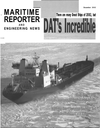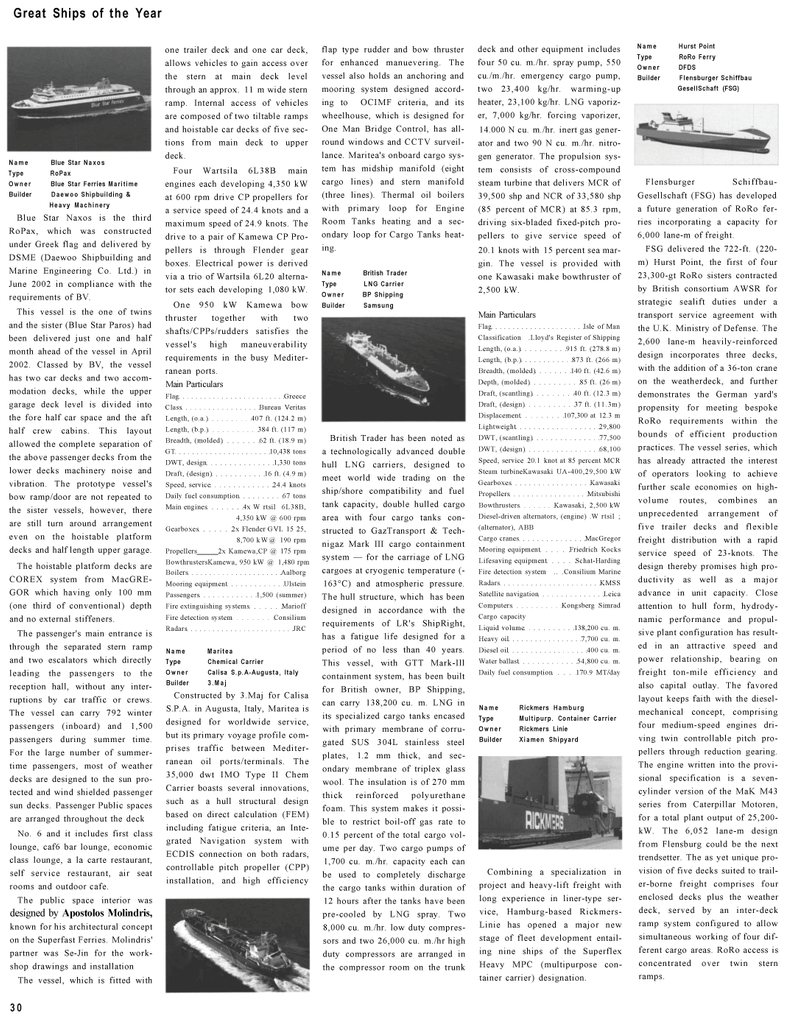
Page 30: of Maritime Reporter Magazine (December 2002)
Read this page in Pdf, Flash or Html5 edition of December 2002 Maritime Reporter Magazine
Great Ships of the Year
Name Blue Star Naxos
Type RoPax
Owner Blue Star Ferries Maritime
Builder Daewoo Shipbuilding &
Heavy Machinery
Blue Star Naxos is the third
RoPax, which was constructed under Greek flag and delivered by
DSME (Daewoo Shipbuilding and
Marine Engineering Co. Ltd.) in
June 2002 in compliance with the requirements of BV.
This vessel is the one of twins and the sister (Blue Star Paros) had been delivered just one and half month ahead of the vessel in April 2002. Classed by BV, the vessel has two car decks and two accom- modation decks, while the upper garage deck level is divided into the fore half car space and the aft half crew cabins. This layout allowed the complete separation of the above passenger decks from the lower decks machinery noise and vibration. The prototype vessel's bow ramp/door are not repeated to the sister vessels, however, there are still turn around arrangement even on the hoistable platform decks and half length upper garage.
The hoistable platform decks are
COREX system from MacGRE-
GOR which having only 100 mm (one third of conventional) depth and no external stiffeners.
The passenger's main entrance is through the separated stern ramp and two escalators which directly leading the passengers to the reception hall, without any inter- ruptions by car traffic or crews.
The vessel can carry 792 winter passengers (inboard) and 1,500 passengers during summer time.
For the large number of summer- time passengers, most of weather decks are designed to the sun pro- tected and wind shielded passenger sun decks. Passenger Public spaces are arranged throughout the deck
No. 6 and it includes first class lounge, caf6 bar lounge, economic class lounge, a la carte restaurant, self service restaurant, air seat rooms and outdoor cafe.
The public space interior was designed by Apostolos Molindris, known for his architectural concept on the Superfast Ferries. Molindris' partner was Se-Jin for the work- shop drawings and installation
The vessel, which is fitted with one trailer deck and one car deck, allows vehicles to gain access over the stern at main deck level through an approx. 11 m wide stern ramp. Internal access of vehicles are composed of two tiltable ramps and hoistable car decks of five sec- tions from main deck to upper deck.
Four Wartsila 6L38B main engines each developing 4,350 kW at 600 rpm drive CP propellers for a service speed of 24.4 knots and a maximum speed of 24.9 knots. The drive to a pair of Kamewa CP Pro- pellers is through Flender gear boxes. Electrical power is derived via a trio of Wartsila 6L20 alterna- tor sets each developing 1,080 kW.
One 950 kW Kamewa bow thruster together with two shafts/CPPs/rudders satisfies the vessel's high maneuverability requirements in the busy Mediter- ranean ports.
Main Particulars
Flag Greece
Class Bureau Veritas
Length, (o.a.) 407 ft. (124.2 m)
Length, (b.p.) 384 ft. (117 m)
Breadth, (molded) 62 ft. (18.9 m)
GT 10,438 tons
DWT, design 1,330 tons
Draft, (design) 16 ft. (4.9 m)
Speed, service 24.4 knots
Daily fuel consumption 67 tons
Main engines 4x W rtsil 6L38B, 4,350 kW @ 600 rpm
Gearboxes 2x Flender GVL 15 25, 8,700 kW@ 190 rpm
Propellers 2x Kamewa,CP @ 175 rpm
BowthrustersKamewa, 950 kW @ 1,480 rpm
Boilers Aalborg
Mooring equipment Ulstein
Passengers 1,500 (summer)
Fire extinguishing systems Marioff
Fire detection system Consilium
Radars JRC
Name Maritea
Type Chemical Carrier
Owner Calisa S.p.A-Augusta, Italy
Builder 3.Maj
Constructed by 3.Maj for Calisa
S.P.A. in Augusta, Italy, Maritea is designed for worldwide service, but its primary voyage profile com- prises traffic between Mediter- ranean oil ports/terminals. The 35,000 dwt IMO Type II Chem
Carrier boasts several innovations, such as a hull structural design based on direct calculation (FEM) including fatigue criteria, an Inte- grated Navigation system with
ECDIS connection on both radars, controllable pitch propeller (CPP) installation, and high efficiency flap type rudder and bow thruster for enhanced manuevering. The vessel also holds an anchoring and mooring system designed accord- ing to OCIMF criteria, and its wheelhouse, which is designed for
One Man Bridge Control, has all- round windows and CCTV surveil- lance. Maritea's onboard cargo sys- tem has midship manifold (eight cargo lines) and stern manifold (three lines). Thermal oil boilers with primary loop for Engine
Room Tanks heating and a sec- ondary loop for Cargo Tanks heat- ing.
Name British Trader
Type LNG Carrier
Owner BP Shipping
Builder Samsung
British Trader has been noted as a technologically advanced double hull LNG carriers, designed to meet world wide trading on the ship/shore compatibility and fuel tank capacity, double hulled cargo area with four cargo tanks con- structed to GazTransport & Tech- nigaz Mark III cargo containment system — for the carriage of LNG cargoes at cryogenic temperature (- 163°C) and atmospheric pressure.
The hull structure, which has been designed in accordance with the requirements of LR's ShipRight, has a fatigue life designed for a period of no less than 40 years.
This vessel, with GTT Mark-Ill containment system, has been built for British owner, BP Shipping, can carry 138,200 cu. m. LNG in its specialized cargo tanks encased with primary membrane of corru- gated SUS 304L stainless steel plates, 1.2 mm thick, and sec- ondary membrane of triplex glass wool. The insulation is of 270 mm thick reinforced polyurethane foam. This system makes it possi- ble to restrict boil-off gas rate to 0.15 percent of the total cargo vol- ume per day. Two cargo pumps of 1,700 cu. m./hr. capacity each can be used to completely discharge the cargo tanks within duration of 12 hours after the tanks have been pre-cooled by LNG spray. Two 8,000 cu. m./hr. low duty compres- sors and two 26,000 cu. m./hr high duty compressors are arranged in the compressor room on the trunk deck and other equipment includes four 50 cu. m./hr. spray pump, 550 cu./m./hr. emergency cargo pump, two 23,400 kg/hr. warming-up heater, 23,100 kg/hr. LNG vaporiz- er, 7,000 kg/hr. forcing vaporizer, 14.000 N cu. m./hr. inert gas gener- ator and two 90 N cu. m./hr. nitro- gen generator. The propulsion sys- tem consists of cross-compound steam turbine that delivers MCR of 39,500 shp and NCR of 33,580 shp (85 percent of MCR) at 85.3 rpm, driving six-bladed fixed-pitch pro- pellers to give service speed of 20.1 knots with 15 percent sea mar- gin. The vessel is provided with one Kawasaki make bowthruster of 2,500 kW.
Main Particulars
Flag Isle of Man
Classification .Lloyd's Register of Shipping
Length, (o.a.) 915 ft. (278.8 m)
Length, (b.p.) 873 ft. (266 m)
Breadth, (molded) 140 ft. (42.6 m)
Depth, (molded) 85 ft. (26 m)
Draft, (scantling) 40 ft. (12.3 m)
Draft, (design) 37 ft. (11.3m)
Displacement 107,300 at 12.3 m
Lightweight 29,800
DWT, (scantling) 77,50
DWT, (design) 68,100
Speed, service 20.1 knot at 85 percent MCR
Steam turbineKawasaki UA-400,29,500 kW
Gearboxes Kawasaki
Propellers Mitsubish
Bowthrusters Kawasaki, 2,500 kW
Diesel-driven alternators, (engine) .W rtsil ; (alternator), ABB
Cargo cranes MacGregor
Mooring equipment Friedrich Kocks
Lifesaving equipment Schat-Harding
Fire detection system .. .Consilium Marine
Radars KMSS
Satellite navigation Leica
Computers Kongsberg Simrad
Cargo capacity
Liquid volume 138,200 cu. m.
Heavy oil 7,700 cu. m.
Diesel oil 400 cu. m.
Water ballast 54,800 cu. m.
Daily fuel consumption 170.9 MT/day
Name Rickmers Hamburg
Type Multipurp. Container Carrier
Owner Rickmers Linie
Builder Xiamen Shipyard
Combining a specialization in project and heavy-lift freight with long experience in liner-type ser- vice, Hamburg-based Rickmers-
Linie has opened a major new stage of fleet development entail- ing nine ships of the Superflex
Heavy MPC (multipurpose con- tainer carrier) designation.
Name Hurst Point
Type RoRo Ferry
Owner DFDS
Builder Flensburger Schiffbau
GesellSchaft (FSG)
Flensburger Schiffbau-
Gesellschaft (FSG) has developed a future generation of RoRo fer- ries incorporating a capacity for 6,000 lane-m of freight.
FSG delivered the 722-ft. (220- m) Hurst Point, the first of four 23,300-gt RoRo sisters contracted by British consortium AWSR for strategic sealift duties under a transport service agreement with the U.K. Ministry of Defense. The 2,600 lane-m heavily-reinforced design incorporates three decks, with the addition of a 36-ton crane on the weatherdeck, and further demonstrates the German yard's propensity for meeting bespoke
RoRo requirements within the bounds of efficient production practices. The vessel series, which has already attracted the interest of operators looking to achieve further scale economies on high- volume routes, combines an unprecedented arrangement of five trailer decks and flexible freight distribution with a rapid service speed of 23-knots. The design thereby promises high pro- ductivity as well as a major advance in unit capacity. Close attention to hull form, hydrody- namic performance and propul- sive plant configuration has result- ed in an attractive speed and power relationship, bearing on freight ton-mile efficiency and also capital outlay. The favored layout keeps faith with the diesel- mechanical concept, comprising four medium-speed engines dri- ving twin controllable pitch pro- pellers through reduction gearing.
The engine written into the provi- sional specification is a seven- cylinder version of the MaK M43 series from Caterpillar Motoren, for a total plant output of 25,200- kW. The 6,052 lane-m design from Flensburg could be the next trendsetter. The as yet unique pro- vision of five decks suited to trail- er-borne freight comprises four enclosed decks plus the weather deck, served by an inter-deck ramp system configured to allow simultaneous working of four dif- ferent cargo areas. RoRo access is concentrated over twin stern ramps. 30

 29
29

 31
31
